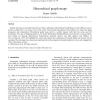Free Online Productivity Tools
i2Speak
i2Symbol
i2OCR
iTex2Img
iWeb2Print
iWeb2Shot
i2Type
iPdf2Split
iPdf2Merge
i2Bopomofo
i2Arabic
i2Style
i2Image
i2PDF
iLatex2Rtf
Sci2ools
CG
2004
Springer
2004
Springer
Hierarchical graph maps
nd maps are powerful abstractions. Their combination, Hierarchical Graph Maps, provide effective tools to process a graph that is too large to fit on the screen. They provide hierarchical visual indices (i.e. maps) that guide navigation and visualization. Hierarchical graph maps deal in a unified manner with both the screen and I/O bottlenecks. This line of thinking adheres to the Visual Information Seeking Mantra: Overview first, zoom and filter, then details on demand (Information Visualization: dynamic queries, star field displays and lifelines, in www.cr.umd.edu, 1997). We highlight the main tasks behind the computation of Graph Maps and provide several examples. The techniques have been used experimentally in the navigation of graphs defined on vertex sets ranging from 100 to 250 million vertices. r 2004 Elsevier Ltd. All rights reserved.
Related Content
| Added | 16 Dec 2010 |
| Updated | 16 Dec 2010 |
| Type | Journal |
| Year | 2004 |
| Where | CG |
| Authors | James Abello |
Comments (0)

